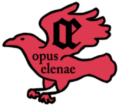Steps Backward: Viking Acanthus Collar
So remember that pretty embroidered collar I had all planned out yesterday? Well…. It’s had some setbacks. Master Alden and I had decided on blue lines for this lovely design. And seeing how much fun I’d had with pearl cotton on the Cantigas pouches, I thought I’d use it again. I had some beautiful robin’s […]
Steps Backward: Viking Acanthus Collar Read Post »
